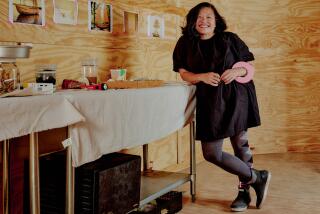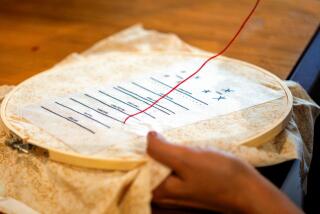Even the poor manage to give
- Share via
As an American tourist visiting Hanoi in 1997, Marichia Simcik Arese extended a simple goodwill gesture to a group of struggling teenage students in Vietnam. The youths were working at a restaurant and using their down-time to fashion picture frames from empty aluminum cans.
“They would sell the frames to pay for their education,” she recalled. “I told them if they would make 50 and send them to me, I would try to sell them in the U.S. and send the money back to them.”
When the package arrived at her Pacific Palisades home a few months later, there were 300 picture frames inside.
“I wanted to put them in the trash -- the recycling bin,” she laughed. “What was I going to do with 300 frames made out of trash?”
But in four months, she managed to unload them “through the PTA, my friends, parents I knew. . . . Everybody I met, I offered a picture frame.”
By March 1998, Arese had raised $7,100. Thrilled, she sent the money back to Vietnam.
Then “magic happened,” she says now. The students decided to keep $1,775 for their education and send the rest to a school in a remote village in northern Vietnam to pay for the education of 10 Hmong orphans.
“That these young people who had so little for their own lives would give so much to help others . . . that was amazing to me,” she said. “In my mind, the concept was born: That giving should not just be the privilege of those who are rich.”
And from that came the Spiral Foundation.
Her foundation started with frequent trips back to Vietnam. She saw streets littered not just with aluminum cans, but with discarded noodle packages and candy wrappers. Gift items could be made, she thought, from recycling that trash. She hired disabled villagers as the artisans.
Then she met a doctor who helped her refine her plan: Proceeds would go to a hospital in Hue City to pay for surgeries for children with heart defects.
Arese -- everyone calls her Marichia -- knew enough about art to design the gifts. A descendant of Italian aristocrats, she holds a doctorate in art history and spent 15 years as a curator at the Getty Museum. She taught the villagers to fashion bowls, bags and other items from bamboo strips wrapped in discarded bits of plastic. “But I knew nothing about marketing,” she said.
So back home she simply displayed the wares on her dining room table, called it a holiday gift bazaar and invited neighbors and friends. Word of mouth did the marketing.
Today, 10 years later, that gift bazaar has grown to an annual event, raised $1.3 million for humanitarian projects in Nepal and Vietnam and funded 240 heart surgeries for children.
Last weekend, Marichia, 55, took in almost $10,000, selling everything from meditation cushions to laptop covers. On Dec. 13 and 14, she will host another holiday bazaar.
I was among dozens of visitors who streamed Sunday through her home, where every surface was covered with stacks of handmade clothing, kitchen wares, desk accessories and other gift items. The artisans get more than wages from their work. “After every heart surgery,” Marichia said, “I bring them to meet with the children and their families.”
She shares a letter from a 20-year-old woman in a wheelchair -- a polio survivor who spent months making colorful ethnic tapestries to fund a little girl’s hospital care.
My joy is double one day after another, for months on end, the letter said. It is joyful when a disabled person like me can do things for others. I never thought I would be able to make a contribution. Thank you.
“Everyone,” Marichia said, “deserves a chance to give.”
My visit to Marichia gave me a chance to think about the season of giving unfolding here, in the midst of this bleak economy.
Something more than a shopping addiction was on display in the long lines outside stores in the post-Thanksgiving rush Friday. We may pare back our Christmas list and resolve to spend less on what we give. But the process of giving pleases the giver -- there’s something self-satisfying about doing something for others.
Five years ago, Bobbie Leibenbaum came to Marichia’s open house to snag a set of pillow covers she’d spotted at the home of a friend. She was moved not just by the colorful wares, but by the chance to add another picture to Marichia’s photo collage of all the children healed by Spiral Foundation gifts. “I decided to do my Christmas shopping here. Every year. All of it. . . . Now, my husband just buys me a heart surgery every Christmas,” she jokes. That’s a couple thousand dollars, from someone who just wanted a more colorful sofa.
That kind of spending is out of reach today for most families. I can’t forget the image of the block-long line at a Montebello park last week, where a woman who once volunteered to pass out donations found herself waiting in line for groceries after she lost one of her jobs.
Even in Pacific Palisades, “a lot of people feel cheated with this economy,” Marichia said. “They can’t help as much as they’d like to.”
So this year, Marichia turned one room of her home into a “bargain room” stacked with inexpensive gifts. I bought a red silk shirt for $10, for a daughter whose new job requires nice clothes but whose paycheck doesn’t cover luxuries.
It’s a purchase that will help two children -- mine and the ill child of an impoverished Vietnamese family. And it’s a gift that gives me the joy of giving.
--
--
Find out more about the Spiral Foundation at www.spiralfoundation.org
More to Read
Sign up for Essential California
The most important California stories and recommendations in your inbox every morning.
You may occasionally receive promotional content from the Los Angeles Times.









